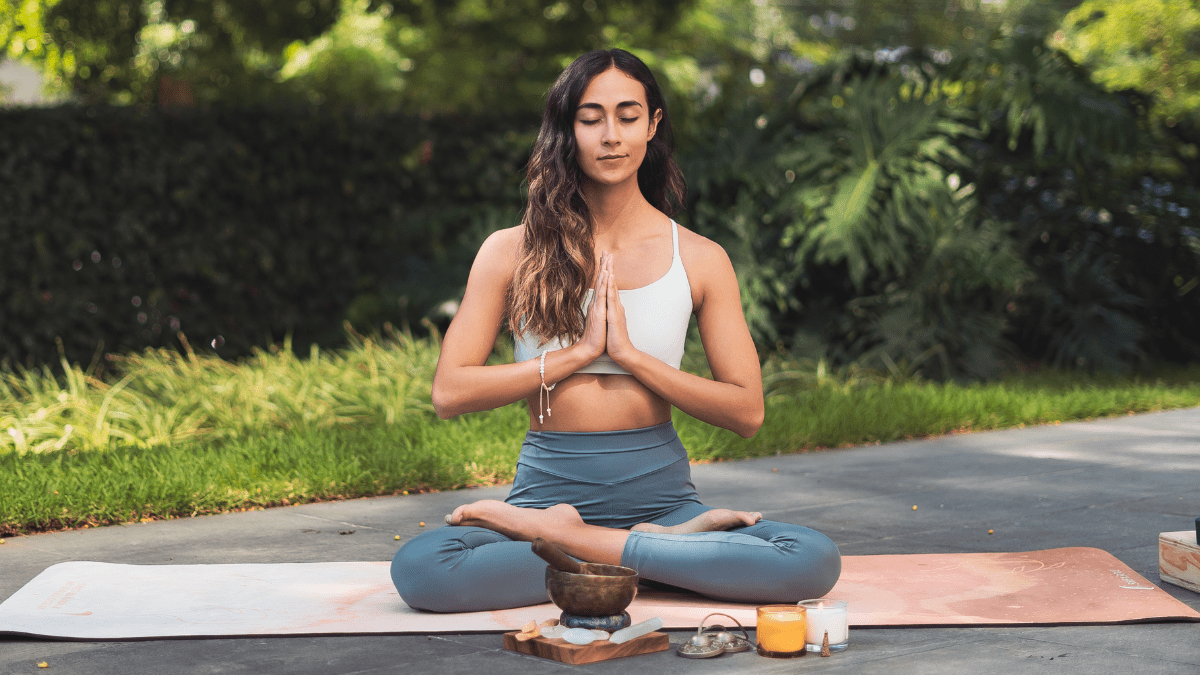Meditation for Sleep: Break Free from Restless Nights Now
Struggling with restless nights? Meditation for sleep can quiet your mind, reduce stress, and guide you into deep, restorative rest. Discover powerful techniques to sleep peacefully tonight.

Tossing and turning, staring at the ceiling, feeling exhausted but unable to drift off—sound familiar? Meditation for sleep offers a natural, powerful way to quiet the mind and reclaim the deep rest you deserve. Instead of battling racing thoughts and stress-induced insomnia, meditation helps you let go, reset, and surrender to sleep effortlessly.
Scientific research confirms that meditation reduces cortisol levels, slows brainwave activity, and activates the parasympathetic nervous system—key factors for quality sleep. More than just relaxation, it rewires your brain to rest deeply, night after night.
In this guide, you’ll discover why sleepless nights happen, how meditation can break the cycle, and the best techniques to help you fall asleep faster and wake up refreshed. Tonight could be the first time in ages you truly rest. Ready to begin?
If you’re new to meditation, check out our guide on How to Start Meditating: A Beginner’s Roadmap to understand the basics before diving into meditation for sleep.
Why You Can’t Sleep: The Real Reasons Behind Restless Nights
Sleep isn’t just about closing your eyes; it’s a delicate balance of hormones, brain activity, and relaxation. If you’re struggling to sleep, there’s a reason—and it’s not just bad luck. Understanding what’s keeping you awake is the first step toward fixing it.
How Stress Disrupts Meditation for Sleep
The moment your head hits the pillow, your brain floods with thoughts:
- Unfinished to-do lists from the day.
- Worries about the future or regrets from the past.
- Racing thoughts that won’t slow down.
Meditation for sleep works by shifting your brain out of this overactive state and into deep relaxation, but first, you need to recognize what’s keeping you stuck.
Why Your Body Resists Meditation for Sleep
Even when you’re exhausted, your body might not be fully prepared to sleep. Some common culprits include:
- Blue light exposure from screens, which disrupts melatonin.
- Caffeine and sugar too late in the day.
- Irregular sleep schedules that confuse your body clock.
Meditation for sleep helps undo these effects, training your body to enter a natural rhythm of rest.
Breaking the Cycle of Restless Nights
The more you struggle with sleep, the more anxious you become about it. This creates a vicious cycle where:
- You dread bedtime, fearing another restless night.
- Your mind and body stay alert instead of relaxing.
- You wake up even more exhausted, making sleep problems worse.
This is where meditation for sleep becomes essential—it helps break the cycle by rewiring your brain’s response to nighttime anxiety.
Studies from the National Sleep Foundation show that stress and anxiety are among the leading causes of poor sleep. Meditation helps combat this by lowering stress hormones and reducing nighttime overthinking.
How Meditation for Sleep Helps You Rest Better
If you’ve ever laid in bed exhausted but unable to switch off your thoughts, you know how frustrating sleepless nights can be. Meditation for sleep is more than just relaxation—it’s a science-backed practice that reprograms your brain to enter deep, restorative rest naturally.
The Science Behind Meditation for Sleep
Research shows that meditation activates the parasympathetic nervous system, also known as the “rest and digest” mode. This helps:
- Lower cortisol levels, reducing stress and anxiety.
- Slow down brainwave activity, shifting from high-alert beta waves to calming theta and delta waves.
- Increase melatonin production, the hormone responsible for sleep.
Studies have found that people who practice meditation for sleep fall asleep faster, wake up less, and experience better quality rest overall.
How Meditation for Sleep Rewires Your Brain
Your brain is highly adaptable, meaning the more you practice meditation, the better your body gets at relaxing on command. Over time, meditation strengthens the prefrontal cortex, the part of the brain that regulates emotions and stress. This helps:
- Reduce nighttime anxiety, making it easier to drift off.
- Detach from racing thoughts, preventing overthinking in bed.
- Improve emotional resilience, so stress doesn’t keep you up.
Real Benefits of Meditation for Sleep
People who consistently practice meditation for sleep often report:
- Falling asleep in minutes instead of hours.
- Sleeping through the night with fewer awakenings.
- Feeling refreshed and energized in the morning.
- Experiencing less stress and anxiety during the day.
With regular practice, you can train your mind and body to embrace rest effortlessly.
Research indicates that deep breathing techniques, such as the 4-7-8 breathing method, can help activate the relaxation response. This technique, recommended by experts at Medical News Today, involves inhaling for 4 seconds, holding for 7 seconds, and exhaling for 8 seconds—helping the body transition into a restful state.
Best Meditation Techniques for Sleep
Not all meditation techniques work the same way, especially when it comes to sleep. The key is to slow down brain activity, relax the nervous system, and shift into a state of deep rest. Below are some of the most effective techniques for achieving that.
Guided Meditation for Sleep
If you struggle to quiet your thoughts, guided meditation can help. A soothing voice leads you through a step-by-step relaxation process, making it easier to let go of stress. Many apps and YouTube channels offer guided meditation for sleep, with themes like deep relaxation, healing, and mindfulness.
Body Scan Meditation for Sleep
This technique helps release physical tension by focusing on different parts of the body. Starting at your toes and moving upward, you slowly bring awareness to each area, noticing sensations and letting go of tightness. Body scan meditation not only relaxes your muscles but also shifts your focus away from anxious thoughts.
Breathing Techniques for Better Sleep
Breathing exercises activate the parasympathetic nervous system, slowing heart rate and calming the mind. Some of the most effective methods include:
- 4-7-8 Breathing: Inhale for 4 seconds, hold for 7, exhale for 8.
- Diaphragmatic Breathing: Deep belly breaths to fully oxygenate the body.
- Box Breathing: Inhale, hold, exhale, and pause for equal counts (e.g., 4-4-4-4).
These techniques help slow brain activity, signaling to your body that it’s time for rest.
Mindfulness Meditation for Sleep
Mindfulness meditation focuses on being present without judgment. Instead of battling racing thoughts, you simply observe them and let them pass. This practice trains your mind to detach from worries and settle into a state of acceptance and peace, making sleep come more naturally.
Yoga Nidra: The Ultimate Sleep Meditation
Often called “yogic sleep,” Yoga Nidra is a powerful practice that guides you into a deep meditative state between wakefulness and sleep. It involves systematic relaxation and visualization, bringing the mind to a place of stillness. Studies suggest Yoga Nidra can provide rest equivalent to several hours of deep sleep.
Each of these techniques can be a game-changer in overcoming sleepless nights. The key is to experiment and find what works best for you.
One of the most powerful sleep-inducing meditation methods is Yoga Nidra, also known as “yogic sleep.” According to Yoga Journal, Yoga Nidra induces a state of deep relaxation similar to the early stages of sleep, making it an effective practice for people struggling with insomnia.
How to Create a Bedtime Meditation for Sleep Routine
Consistency is key when using meditation for sleep. A structured bedtime meditation routine signals to your brain that it’s time to unwind, making it easier to fall asleep naturally. Here’s how to create a routine that works.
1. Set Up a Sleep-Friendly Environment
Your surroundings play a major role in how quickly you relax. Before meditating, make sure your bedroom supports deep sleep:
- Dim the lights at least an hour before bed.
- Reduce screen time to limit blue light exposure.
- Use calming scents like lavender or sandalwood.
- Keep your room cool and quiet to promote restful sleep.
A peaceful setting enhances the effects of meditation for sleep, helping your body transition into rest mode.
2. Choose the Right Time for Meditation
While some people meditate right before bed, others find it helpful to practice a few hours earlier to ease into relaxation. Test different timings to see what works best for you:
- Before bed: Helps slow the mind and body for immediate sleep.
- After dinner: Relieves stress before winding down for the night.
- During nighttime wake-ups: Can help you fall back asleep faster.
3. Start Small and Build Consistency
If you’re new to meditation, don’t overwhelm yourself with long sessions. Begin with just 5 to 10 minutes and gradually increase the duration as it becomes a habit. The goal is to make meditation for sleep a natural part of your nightly routine.
4. Use Guided Meditation or Background Sounds
If silent meditation feels challenging, try using external aids to create a soothing atmosphere:
- Guided sleep meditations (available on apps like Calm, Insight Timer, or YouTube).
- White noise or nature sounds to block distractions.
- Binaural beats or delta wave music designed to slow brain activity.
These tools enhance the effectiveness of meditation for sleep, making it easier to drift off effortlessly.
5. Let Go of Expectations
One of the biggest mistakes people make is expecting immediate results. Meditation isn’t about forcing sleep—it’s about training your mind to relax over time. If your thoughts wander, gently bring your focus back without frustration. The more you practice, the easier it becomes to slip into deep rest naturally.
By following these steps, you can build a bedtime meditation routine that works for you, leading to better sleep, less stress, and more energy in your daily life.
If you’re looking for a structured approach to bedtime meditation, apps like Calm and Insight Timer offer guided meditations specifically designed to improve sleep. These resources make it easier for beginners to develop a consistent meditation habit.
Meditation for Sleep: Common Struggles and How to Overcome Them
Even with the best intentions, some people find it difficult to use meditation for sleep effectively. If you’ve tried meditating but still struggle with restless nights, you’re not alone. Here are the most common challenges and how to overcome them.
“I Can’t Stop My Thoughts”
One of the biggest misconceptions about meditation is that you need to completely silence your mind. That’s not true. The goal isn’t to eliminate thoughts but to observe them without attachment.
Solution:
- Instead of resisting thoughts, acknowledge them and gently return to your breath or the meditation guidance.
- Try mantra meditation, repeating a calming phrase like “I am at peace” to keep your mind focused.
- Guided meditation can be particularly helpful in keeping you engaged without overthinking.
“I Don’t Have Time for Meditation”
Many people skip meditation for sleep because they think it requires too much time. However, even a few minutes can make a difference.
Solution:
- Start with just 5 minutes before bed. Even short sessions can have a profound effect.
- Incorporate meditation into your existing bedtime routine—such as after brushing your teeth or right before turning off the lights.
- Use sleep-friendly meditation apps with quick sessions tailored for busy schedules.
“Meditation for Sleep Doesn’t Work for Me”
Some people try meditation a few times and give up, thinking it doesn’t work. In reality, meditation is a practice—it takes time to train your brain for better sleep.
Solution:
- Be consistent. Just like exercise, meditation becomes more effective with regular practice.
- Try different techniques—not all meditations work for everyone. If mindfulness doesn’t help, consider body scan meditation, breathing exercises, or Yoga Nidra.
- Pair meditation with other sleep-promoting habits like reducing caffeine intake, following a sleep schedule, and limiting screen time.
“I Fall Asleep During Meditation”
While meditation for sleep is meant to promote rest, some people worry that falling asleep during the practice means they’re doing it wrong.
Solution:
- If your goal is better sleep, falling asleep during meditation is fine—it means your body is responding.
- If you want to stay awake to deepen your practice, try sitting up instead of lying down.
- Focus on breathing techniques that keep you relaxed but aware, rather than those designed specifically to induce sleep.
By addressing these challenges, you can improve your meditation practice and make it a reliable tool for falling asleep faster and waking up refreshed.
Curious how meditation compares to sleep? Read this honest take on whether meditation can truly replace rest.

Frequently Asked Questions (FAQ) About Meditation for Sleep
1. How long does it take for meditation to improve sleep?
Some people notice improvements after just one session, while others need a few weeks of consistent practice. Over time, meditation trains your brain to relax more easily, making sleep come naturally.
2. What is the best type of meditation for sleep?
The best meditation depends on your needs. Guided meditation is great for beginners, while body scan meditation helps release tension. Breathing exercises and Yoga Nidra are also highly effective for deep relaxation.
3. Can I meditate in bed?
Yes! Meditation for sleep is designed to be done while lying down. You can also meditate while sitting if you prefer to stay awake longer before drifting off.
4. What if I fall asleep during meditation?
That’s completely fine! If you’re using meditation for sleep, falling asleep is the goal. Your body is responding to relaxation, which means the practice is working.
5. How long should I meditate before bed?
Even 5-10 minutes can make a difference. If you have time, 20-30 minutes can deepen relaxation and improve sleep quality. The key is to be consistent.
6. Can meditation replace sleep?
No, meditation doesn’t replace sleep, but it can enhance sleep quality. Some practices, like Yoga Nidra, can feel as restorative as a few hours of deep sleep, but they’re not a substitute for actual rest.
7. Should I listen to music while meditating for sleep?
Soft background music, nature sounds, or binaural beats can enhance meditation for sleep. However, some people prefer silence or guided meditation—experiment to see what works best for you.
8. What should I do if meditation doesn’t seem to help?
Give it time and try different techniques. You can also combine meditation with other sleep-friendly habits, like avoiding screens before bed, reducing caffeine, and sticking to a sleep schedule.







